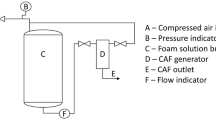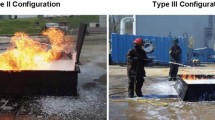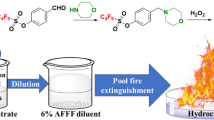Abstract
This contribution describes the experimental program undertaken to test the performance of a novel firefighting foam against the current Class B foam technology. The novel foam involved the use of a chemical reaction between dissolved species to generate inert nitrogen gas in situ; hence in situ generated nitrogen foams (ISNF). The experimental program encompassed the utilisation of the DEF(AUST)5706 test standard for measuring the suppression and burnback performance of the ISNF as well as that of compressed air foams (CAF). All tests were performed using the same two types of surfactant concentrates (one telomer and one PFOS-based) in order to accurately determine the effect of the generation technology on the foam performance. The three kinds of foams (i.e., aspirated, CAF and ISNF) were characterised in terms of their bubble size distributions and drainage rates. Bubble size analysis placed the size distribution of the ISNF midway between those of aspirated and compressed air foams, whilst drainage performance was found to be only slightly superior to the aspirated foam. The results of the experiments showed that in situ nitrogen foams are able to achieve good performance, similar to that of aspirated and CAF technologies. Further work is needed to optimise foam formulations for ISNF so that surfactants are not affected by the chemistry of nitrogen generation and by the presence of salts formed during chemical reactions.







Similar content being viewed by others
References
DEF(AUST)5706 (2003) Foam, liquid fire extinguishing; 3 percent and 6 percent concentrate specification. Commonwealth of Australia, Australian Defence Standard
Laundess AJ, Rayson MS, Kennedy EM, Dlugogorski BZ (in press) Small-scale test protocol for firefighting foams DEF(AUST)5706: effect of bubble size distribution and expansion ratio. Fire Technol
Persson B, Lönnermark A, Persson H, Mulligan D, Lancia A, Demichela M (2001) FOAMSPEX: large scale foam applications––modelling of foam spread and extinguishment. SP Report 2001:13.
Lefebvre AH, Atomization and Sprays, Hemisphere Publishing Corporation, New York, 1989.
Magrabi SA, Dlugogorski BZ, Jameson GJ (1999) Bubble size distribution and coarsening of aqueous foams. Chem, Eng. Sc.i 54: 4007-4022.
Ruckenstein E, Bhakta A (1997) Decay of standing foams: drainage, coalescence and collapse. Adv. Colloid Interface Sci 70: 1-124.
Angasarka JK, Tachev KD, Kralchevsky PA, Mehreteab A, Broze G (1998) Effects of Counterions and Co-ions on the Drainage and Stability of Liquid Films and Foams. J. Colloid Interface Sci 200: 31-45.
Defence Standard 42-40, Issue 2 (2002) Foam liquids, fire extinguishing (concentrates, foam, fire extinguishing). UK Ministry of Defence
Dlugogorski BZ, Kennedy EM, Rayson M, da Silva G (2007) Methods of gassing explosives especially at low temperatures, PCT, priority date 10 Jan 2007, pp 1–66
Author information
Authors and Affiliations
Corresponding author
Appendix
Rights and permissions
About this article
Cite this article
Laundess, A.J., Rayson, M.S., Dlugogorski, B.Z. et al. Suppression Performance Comparison for Aspirated, Compressed-Air and In Situ Chemically Generated Class B Foams. Fire Technol 48, 625–640 (2012). https://doi.org/10.1007/s10694-010-0155-z
Received:
Accepted:
Published:
Issue Date:
DOI: https://doi.org/10.1007/s10694-010-0155-z




